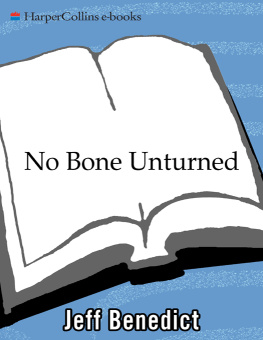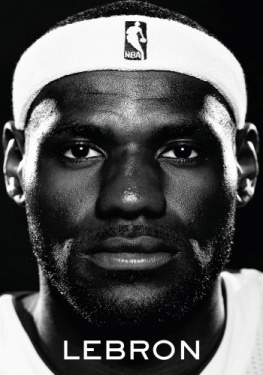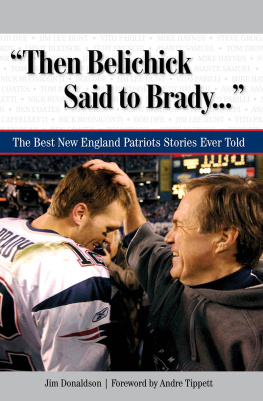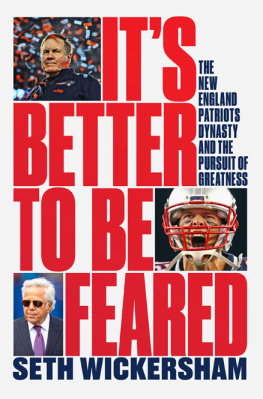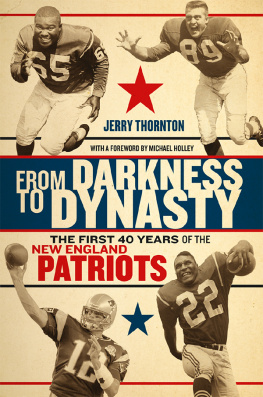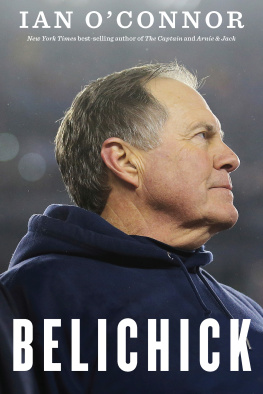Thank you for downloading this Simon & Schuster ebook. Get a FREE ebook when you join our mailing list. Plus, get updates on new releases, deals, recommended reads, and more from Simon & Schuster. Click below to sign up and see terms and conditions. CLICK HERE TO SIGN UP Already a subscriber? Provide your email again so we can register this ebook and send you more of what you like to read. You will continue to receive exclusive offers in your inbox. To Art Taylor, the man who was most responsible for my becoming a writer. In 1992, when I was fresh out of college, he invited me to Boston and offered me a research internship. This opportunity exposed me to influential writers. At that point, I had never considered writing as a career choice. Art changed that. More important, he believed in me and took a personal interest in my future. Its amazing how far a little encouragement can take you. Over the years, Art read every one of my books, but he was particularly thrilled about this one. I was still working for him when Robert Kraft purchased the Patriots franchise in 1994. Art loved the Patriots, and when I told him in 2018 that I was writing a book on the Patriots dynasty, he told me that he could not be prouder. He couldnt wait to read it. But in June 2019, Art passed away. Art, this ones for you and your lovely wife, Ann-Louise. Thank you for believing in me. Thank you for giving me a chance. I will always love you.
Prologue
W earing a surgical mask, a gown, and latex gloves, Dr. David Berger stood over Drew Bledsoe and made a careful incision in his chest. It was the evening of Sunday, September 23, 2001, and high-intensity ceiling lights in a trauma bay at Massachusetts General Hospital illuminated the thirty-seven-year-old surgeons steady hands. Bledsoe, the starting quarterback for the New England Patriots, had an oxygen cannula in his nose and IV fluids flowing into his veins to resuscitate him. The twenty-nine-year-old had lost over a third of his blood through a partially severed artery that was pulsing into his chest cavity and preventing his left lung from expanding. Berger needed to get the internal bleeding under control or Bostons most famous athlete would die. But first, he had to remove the blood from Bledsoes chest.
Inserting a slim tube in the incision, Berger gingerly snaked it under Bledsoes skin, over a rib, and into the space between the lung and the chest wall where the blood was pooling. Within moments, blood began flowing from Bledsoes chest through the tube into a machine equipped with filters that removed clots and other impurities. The machine then re-transfused the clean blood back into Bledsoe through a second tube that flowed into one of his veins.
As soon as Bledsoes lung started working again, Berger turned his attention to the sheared artery. When a patient loses a liter and a half of blood, standard medical protocol calls for surgery to stop the bleeding. But Bledsoe wasnt a standard patienthe was the most talented quarterback in team history and had just signed a ten-year, $103 million contract that made him the highest-paid player in the National Football League.
Reluctant to operate, Berger talked to Bledsoe and his wife, Maura, together. The injury, he explained, was to Drews left chest. When a right-handed thrower like Drew brought the ball back, cocked his arm, and then extended it forward, he was rotating around on his left chest, using all of those muscles to generate the torque to throw. I will have to cut at least some of those muscles, Berger told Drew. Then Berger turned to Maura. The procedure could potentially end his football career, he told her.
Bledsoe was adamant that he didnt want surgery.
Berger explained that sometimes an artery will stop bleeding on its own, averting the need for surgery. Under the circumstances, Berger recommended keeping the chest tube in and closely monitoring Bledsoe. If the bleeding didnt stop within a few hours, hed have no choice but to go in.
Two hours earlier, Berger had been at home enjoying a quiet dinner with his family when he received a call from Dr. Tom Gill, a New England Patriots team physician. Berger and Gill were friends. At Gills urging, the Patriots had started using Berger as a surgical consultant a couple of years earlier. Berger had a reputation for being the busiest surgeon at Mass General, where he performed about eight hundred operations a year. The moment he heard Gills voice, Berger knew this wasnt a social call.
Can you meet Drew over at the MGH emergency room? Gill said in an urgent tone.
Berger asked what was going on. Gill said he wasnt sure. Late in the fourth quarter, he explained, Bledsoe had been running with the ball toward the Patriots sideline when he was blasted by New York Jets linebacker Mo Lewis. The hit was so violent that players along the Patriots sideline compared the sound of the collision to a car crash. Bledsoe went airborne, and his face mask bent. After lying on the turf for a minute or so, he finally got up and made his way to the bench. He returned to the field on the Patriots next possession. But coach Bill Belichick replaced him moments later when it became apparent that Bledsoe couldnt remember the plays. When the game ended, he was taken to the locker room to be examined. X-rays were inconclusive, but his vital signs were troubling. High heart rate. Faint pulse. Shallow breathing. He was complaining of pain in his left chest and was beginning to be short of breath.
I think he has an internal injury, Gill told Berger, wondering aloud if Bledsoe might have ruptured his spleen.
Berger knew that Bledsoe was the linchpin of the Patriots team, the face of the franchise.
Hes on his way to the hospital? Berger asked.
Were putting him in an ambulance now, Gill said.
Ill be there.
The Patriots backup quarterback, Tom Brady, used the locker next to Bledsoes in the team locker room. While changing out of his uniform after the game, Brady watched the medical staff escort Bledsoe from the training room. Brady was twenty-four and had just begun his second season in the NFL. Hed seen some big hits in college, but nothing like the one Bledsoe had sustained. And the sight of his friend and mentor being placed on a gurney and loaded into the back of an ambulance had him deeply concerned. Brady and Bledsoe were close. Brady often hung out at Bledsoes home, and Maura frequently cooked him dinner. He felt like he was part of the family.
Brady quickly got dressed and drove straight from the stadium to the hospital. It was his first trip to Mass General. Unrecognizable in Boston, he had trouble getting past security at the nurses station outside the trauma unit. He had to convince the hospital staff that he was Drew Bledsoes backup. Eventually, he talked his way in and followed signs to the waiting room, where he discovered Maura, alone and crying.
Brady put his arms around her. Whats going on ? he asked.
Wiping her eyes, Maura brought him up to speed. Theyre deciding whether to go in and repair the artery, she said. If it doesnt stop bleeding on its own, it could be career-ending.
Brady couldnt believe what he was hearing.
Down the hallway, Robert Kraft huddled with one of the team doctors who were closely monitoring the situation. Kraft wanted to know the prognosis. The doctor was direct. Mo Lewiss hit, he explained, had resulted in an injury unlike anything hed ever seen in a professional athlete. When Lewis hit Bledsoe he broke a number of his ribs, despite the fact that Bledsoe was wearing a flak jacket. The jagged edges of the broken ribs tore an artery in Bledsoes chest, causing internal bleeding. The official medical diagnosis was that Bledsoe suffered a hemothoraxa collection of blood in the space between the chest wall and the lung. Roughly 50 percent of the blood circulating through Bledsoes body ultimately leaked into his chest and needed to be drained. He also had a pneumothoraxa collapsed lung. Apparently, one of his broken ribs had poked a hole in it.
Next page

